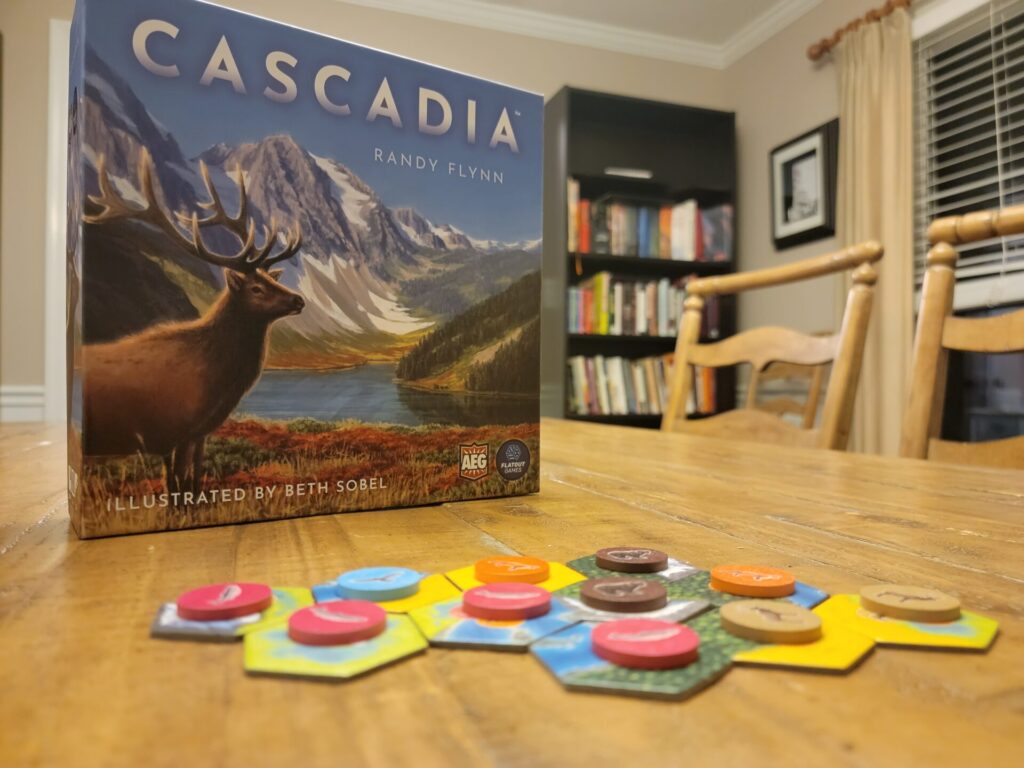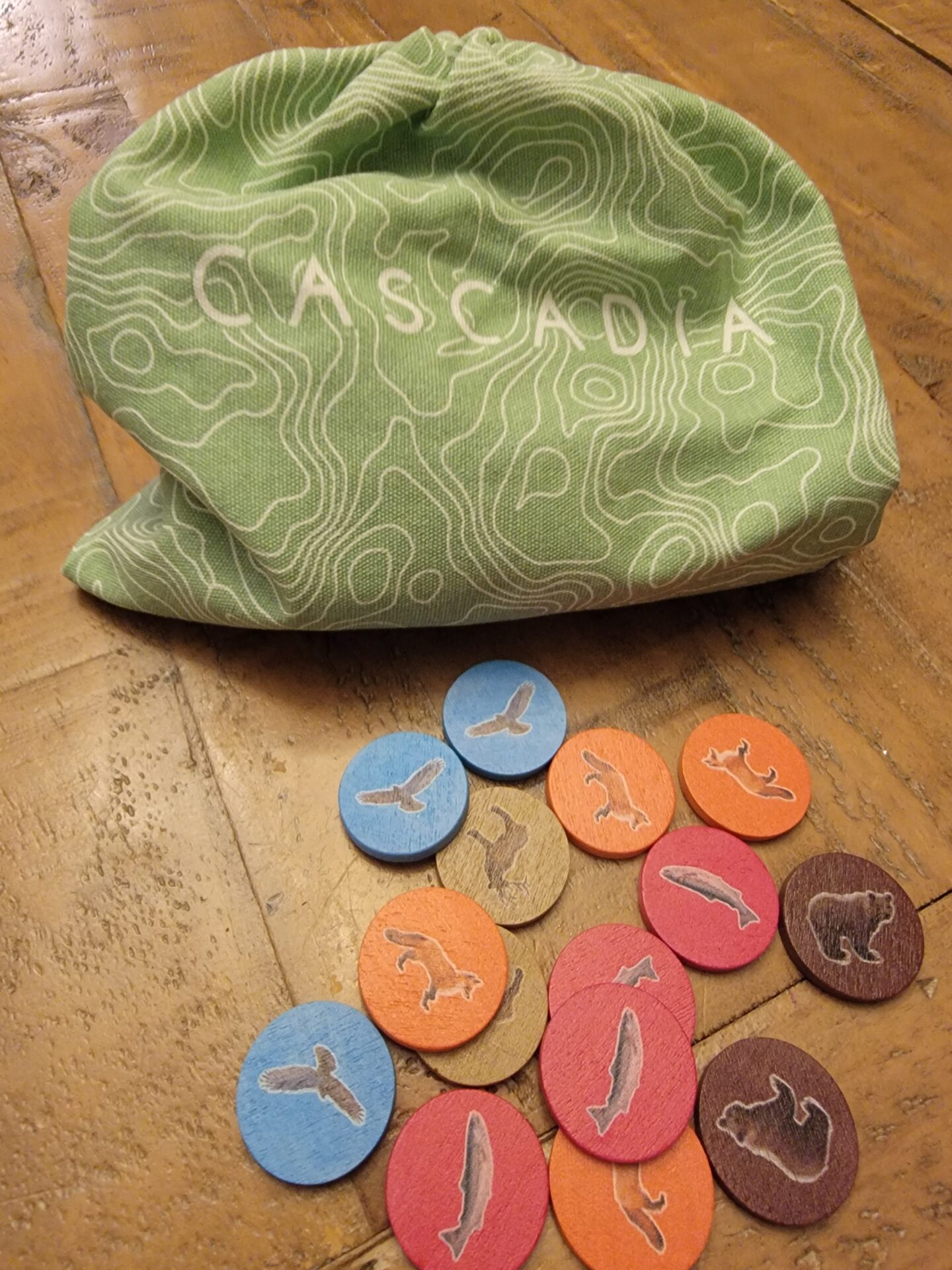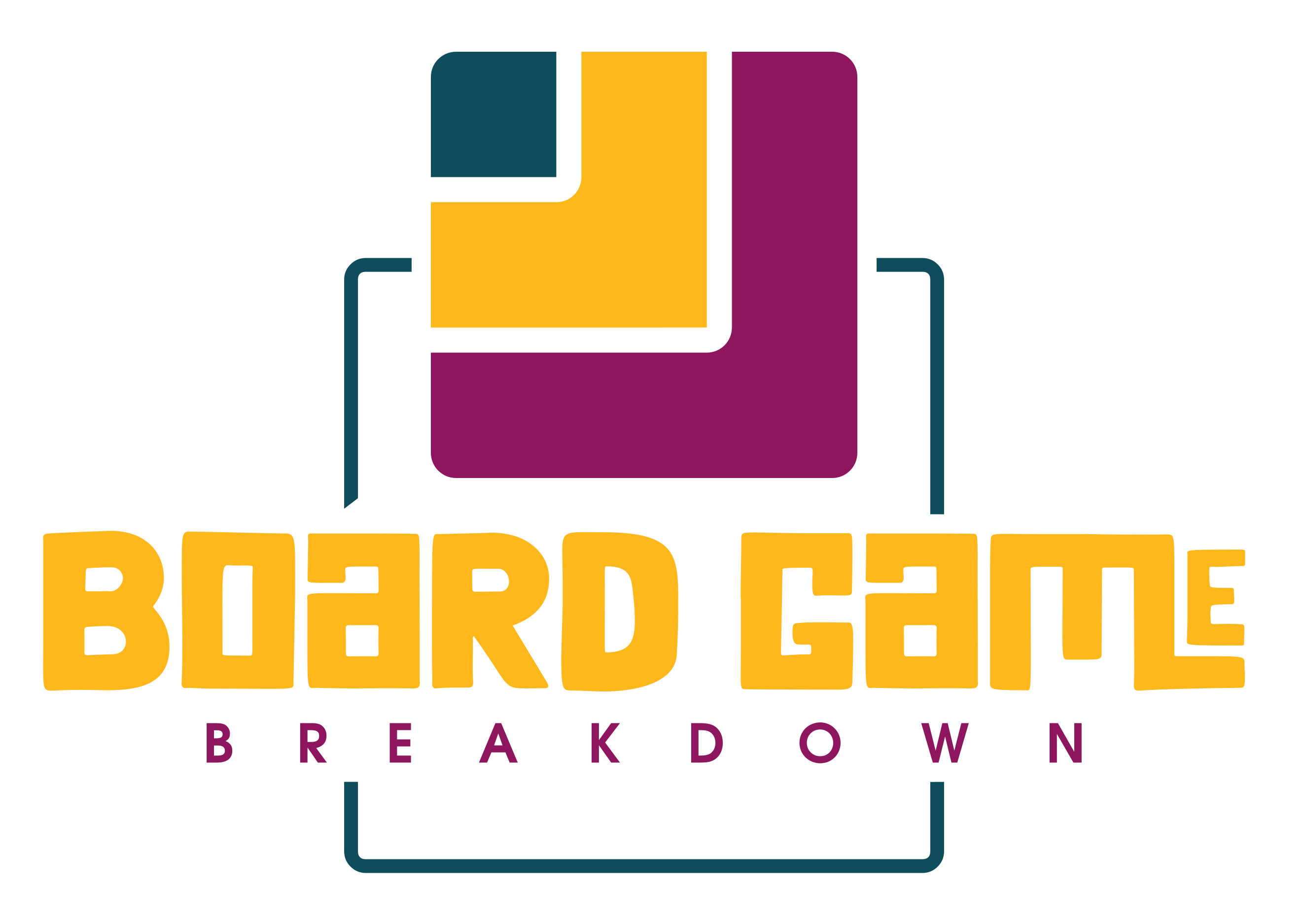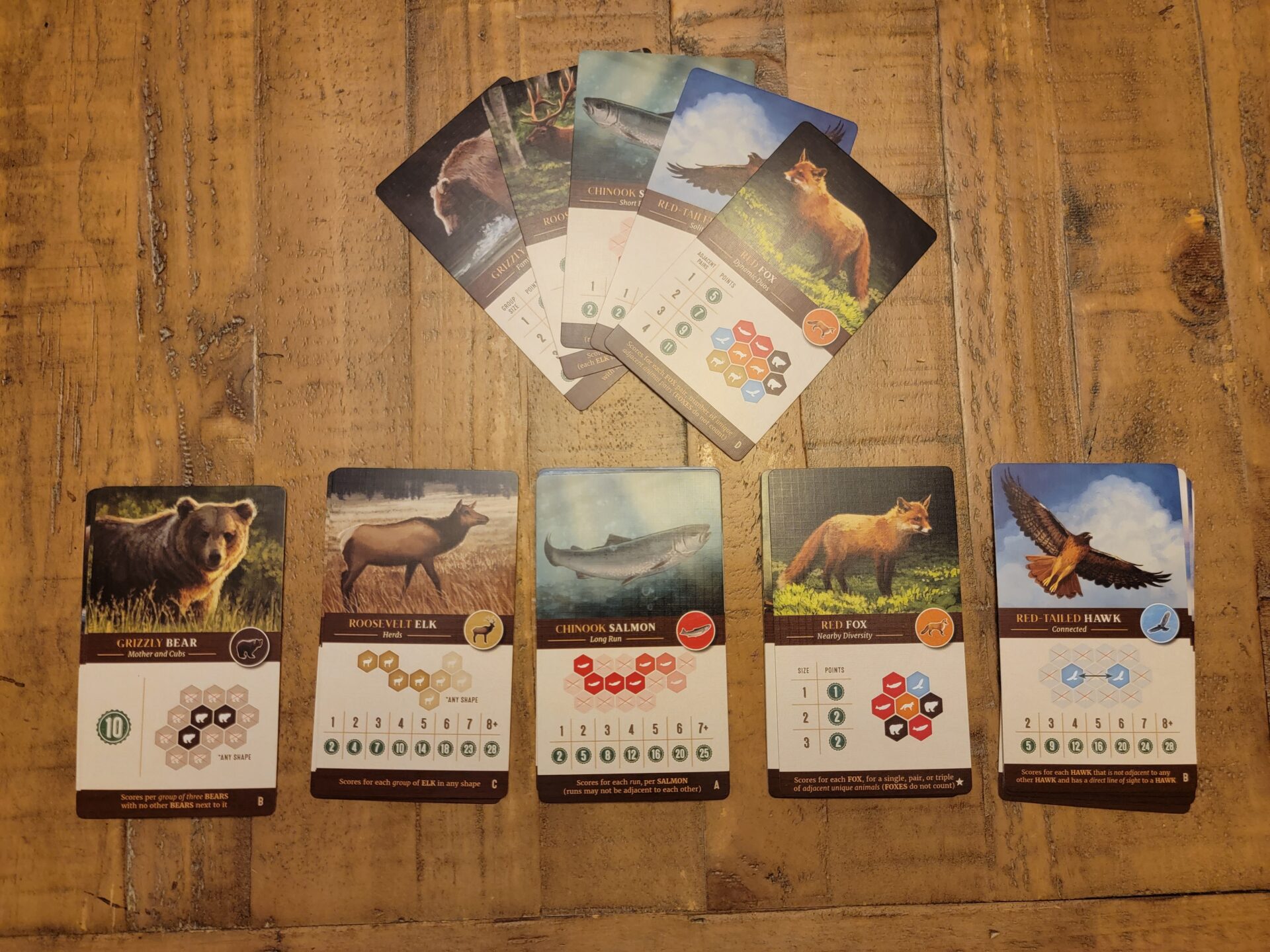
Name: Cascadia
Year of Release: 2021
Player Count: 1 – 4 Players
Playing Time: 30 – 45 minutes
Designer: Randy Flynn
Publisher: Flatout Games
Primary Mechanisms: Tile Placement, Open Drafting, Pattern Building
Weight (According to boardgamegeek.com): 1.88
This post contains two reviews, beginning with the general overview of Cascadia and discussing, in detail, thoughts on the rulebook, setup, and components, as well as a solo variant review.
To read the general review, continue reading below. To go directly to the solo variant review towards the end of this page, click here.
Overview
Cascadia was my first venture into backing anything on Kickstarter. The advent of becoming a backer for this wonderful looking game brought on a new excitement which was only fueled more when I got an email letting me know that the “Print-N-Play” files were ready to download. I have dabbled in PnP games a few times, but nothing stuck. That changed with Cascadia. I played the PnP version for weeks after, even getting my kids involved. I originally wrote this review based on parts of the PnP version, but I have gone back and revised to cover the Kickstarter version of the game.
In my original review, I mentioned I thought that this game was going to make a big splash with certain people, and I’m not surprised that this was a correct assumption. At the time of this revision, Cascadia sits at number 72 on the BGG.com Hot 100 List and is number 1 in the “Abstract” category and in my opinion, it deserves this spot wholeheartedly.
Rulebook and Setup
When I think of Cascadia, one of the first things I think about is the rulebook, which is a really strange thing as this isn’t typical of most games. Sure, the rulebook looks beautiful and is concise and straight-forward when laying out all the aspects of the game, but those aren’t the reasons I think about it. The reason I think about it is found in the last collection of pages in the book, and this is the section that details all the different “scenarios” and “achievements” to try out (called the Cascadia Achievement System.) A lot of the games that came out in the past year have implemented a similar concept and I’m loving this trend. The surge of endorphins I get when I’ve reached a goal enhances the solo variant of any game I play.
The first page (of the Cascadia Achievement System section) lays out a map of the Cascadia region with space for five different players to record their trek through the region. The trek is represented by meeting more and more achievements as you continue to play. The next few pages after the map, hold the different achievements for you to reach. If you are a video game player, you might recognize this style of incentive, instantly thinking of the little Xbox sound and graphic popping up on your screen, communicating that you have killed enough players with a certain firearm or scanned a certain amount of fauna on an alien planet.
Some of the achievements direct you to play with a certain combination of the animal scoring cards, called a scenario. To be successful at the achievement, you must not only score a minimum of X points, but you also must do it by scoring at least 3 animal Y objectives. Elsewhere, achievements modify the rules slightly for your next game, forcing you to play with no pinecone tokens available. As you meet the achievements, you fill in another marker on the map, illustrating your continued trek and growing expertise of the Cascadia region. I played two nights in a row recently, working on achievement 5 in both. I failed the first night by quite a bit, but on the second night, when I finally drew the last Red-Tailed Hawk token I needed and ended up beating the achievement by a single point, I was filled with joy. I actually felt like I achieved the achievement. It is the simple things in life, right?
Setup literally only takes 5 minutes (or so my scribbles in OneNote tell me from the notes I took last night during a play through.) The largest chunk of time is sunk in pulling out the 43 habitat tiles (from the full complement of 85) to play the solo version. The amount of habitat tiles varies on player count but is always a number which allows a set number of 20 rounds per player. The rest of the setup is making sure all 100 animal tokens are in the Cascadia branded draw-string bag. When I was obsessed with the PnP version, I was carrying mine around in a paper bag. (Note: my wife says it looks like I am heading to the middle school cafeteria to play Magic the Gathering…. Do middle schoolers even play that anymore?) You also need to choose one scoring card for each of the five animals. Put a pin in the scoring cards because this is one of my favorite aspects of the game, so I will come back to that. The player flips over four of the habitat tiles, lines them up in the middle of the table, and grabs four animal tokens from the bag, placing one animal token under each habitat tile. You just grab yourself a starter tile (basically three habitat tiles joined together) and you are ready to go!
Components

There aren’t a ton of fancy components in Cascadia but the game is better for it. It is streamlined, it is portable, and it carries no extra baggage with it. The 85 habitat tiles are printed on quality cardboard that feels nice in your hands as you draft from the middle of the table. The artwork on the tiles themselves is pretty standard for a tile laying game but the regions are easy to differentiate, so no real complaints there.
Along with the habitat tiles, you get 100 animal tokens. These are small wooden tokens, printed in one of five colors and printed with one of the five animal species you are playing with. I appreciate that the design team went with wooden tokens instead of carboard chits as it gives the game a higher quality feel. The game also comes with a bag to put the tokens into for drawing purposes, a handful of carboard pinecone chits, and a score pad.
The last component you’ll receive are the scoring cards and these are my favorite parts of the game, so I want to talk about them in some depth. As mentioned above, there are five species of animals represented on the tokens and each of these has a unique scoring card. Not only do they have a unique scoring card per species, but each species also actually ships with four different cards and Kickstarter backers are awarded with a fifth scoring card for each species! The mixing of these scoring card for each game gives each game a different feeling and greatly increases re-playability.
The five species focused on in the game are: Grizzly Bear, Roosevelt Elk, Chinook Salmon, Red-Tailed Hawk, and the Red Fox. Honestly, I do not know much about how these animals interact with their habitats, their prey, their predators, or each other. But what I do know is, the designers of Cascadia make me feel that the different scoring objectives correspond with their species nicely. An example might be that most of the Red-Tailed Hawk objectives score you points for hawk tokens that have a direct line of sight to another hawk token but that are non-adjacent. On the other hand, a lot of the Grizzly Bear objectives revolve around creating small groups of one, two, or three bear tokens but not more than three and these groups should never be adjacent. Again, I have no clue if these characteristics relate to these species in any way in the natural world, but the game makes me feel like they might and that is all that matters to me. Much like variable player powers, I am a sucker for variable scoring conditions. Something about having to change my strategy slightly to meet the new conditions from game-to-game just hits the right chord for me as a gamer.
Gameplay

On a turn, the player chooses one habitat tile as well as the corresponding animal token under it, and places it in their ecosystem they are building. Once placed, the tile and the token is replaced and the turn moves to the next player. Rinse and repeat till you have completed 20 rounds (at which you will be out of habitat tiles to refill the row) and you are done. There are a few instances where you can modify what is in the row, but this goes quick enough, and you are right back into the action. These instances will mainly revolve around when you choose to spend a pinecone token, which you are rewarded when you place an animal token in a “Keystone” habitat. Basically, these habitat tiles only have one individual type of animal that can be placed and are only ever made up of one habitat type. When you spend a pinecone token, you can choose one habitat tile and one animal token from the row, no matter if they are paired together. This gives you some leeway when you really need a certain animal to meet an objective, but really do not need the habitat tile it is paired with. Other instances include when too many of the same animal species tokens appear in the row (called Overpopulation) and they must be replaced with a new draw from the bag.
The game is relatively fast and doesn’t outstay it’s welcome. Like many other abstract games, it might feel more like a puzzle to some than a board game and I can’t fault anyone for that opinion, but to me, I like the puzzle aspect. There are actually two puzzles going on at once and that is something I really like. I mentioned the animal scoring cards already, but the players also get points for connecting tiles of the same region. It feels freeing knowing that I’m allowed to place my tiles anywhere and they don’t have to match with their adjacent neighbors but if I decide to do it, I can score some bonus points at game end.
My biggest complaint is that there just isn’t a lot of interaction between players. Yes, one of the main mechanics is open drafting tiles so there is always a chance that you take a tile your opponent needs but I find that it’s rare that you get stuck with a set of tiles that won’t somehow work into your environment. Most of my play throughs against an opponent, I’ve never once even glanced at their side of the table as it just doesn’t have any bearing on what I’m doing. I will say that because of this, this game does play very nicely as a solo which I’ve discussed in a little more detail here.
Solo Variant Review
Turns are easy enough and this is one of this game’s advantages when it comes to solo gaming. In solo gaming, I am fairly turned off when there is a lot of upkeep, or fiddling, I must do each round. One, I just find this part of a game boring when I am by myself. I do not mind it when playing with others, as we can split up the tasks and there is conversation happening, but in a solo game, I want the turns to be as efficient as possible. Two, I discover in a lot of games where it is not a strictly solo game, a lot of the upkeep tasks do not seem very organic to the game and can easily be forgotten or missed. I hate the feeling when I am three turns into something and realized I have skipped over some function I should have done and now I might as well not even move forward. Alas, Cascadia has none of this so that’s bonus points in my book.
On a turn, the player chooses one habitat tile as well as the corresponding animal token under it, and places it in their ecosystem they are building. Once placed, they discard the left most habitat tile and animal token in the row, re-fill the row with two more tiles and two more tokens, and then it is time for round two. Rinse and repeat till you have completed 20 rounds (at which you will be out of habitat tiles to refill the row) and you are done. There are a few instances where you can modify what is in the row, but this goes quick enough, and you are right back into the action. These instances will mainly revolve around when you choose to spend a pinecone token, which you are rewarded when you place an animal token in a “Keystone” habitat. Basically, these habitat tiles only have one individual type of animal that can be placed and are only ever made up of one habitat type. When you spend a pinecone token, you can choose one habitat tile and one animal token from the row, no matter if they are paired together. This gives you some leeway when you really need a certain animal to meet an objective, but really do not need the habitat tile it is paired with. Other instances include when too many of the same animal species tokens appear in the row (called Overpopulation) and they must be replaced with a new draw from the bag.
As with many abstract games, the solo variants can feel much more like a puzzle and Cascadia is no different. The player has a lot more control over the tiles as he/she knows which one will be discarded every time. There is no wondering which tile your opponent will steal, as all the needed information is on the table. Typically, I don’t care too much for these types of solo plays because the designers end up just printing some table of scores in the manual that you’ll judge your score against. Not very fulfilling if you think about it. Thankfully, the designers of Cascadia went a different route.
Instead of a simple table, they created an entity called the Cascadia Achievement System. In the full review, I go into a lot more detail but suffice to say, this system outlines numerous different scenarios and achievements for the player to master. Just the combination of different scoring cards alone is going to keep a solo gamer busy for quite a while. Add in some slight rule changes in order to meet certain achievements, and I think that most solo gamers will be happy with the outcome.
Conclusion

Cascadia is a superb and fun tile-laying game that knows what it is and does that thing very well. This was one of my favorite releases of 2021 and never find myself getting bored of it. The different combinations of scoring cards matched with the Cascadia Achievement System offers plenty of re-playability, especially for a solo gamer, and I continue to trek through this wonderful game time and time again. If you’re looking for a quick abstract, with barely any setup, and that is surprisingly portable, make sure to check out Cascadia.
Rating
Ratings are based on 5 main criteria: rulebook, setup, components, art & graphic design, and gameplay. The first 4 criteria are rated 1 to 5 and the gameplay is rated 1 to 10. These scores culminate in an “overall satisfaction” score that is rated from 1 to 10. If the reviewed game has both a solo and multiplayer mode, I have assigned scores separately to give context to which mode we enjoy more.
Links
As an Amazon Associate I earn from qualifying purchases.
Amazon: Cascadia Board Game


Hi. I read your review of Obsession on BGG and followed you to your website. I enjoyed your reviews (Obsession & Cascadia so far) for their efficiency of covering game play and personal impressions. Nice to share this great hobby with you.
John,
Thank you for your kind words and we are looking forward to putting more content out every week! Stay tuned!